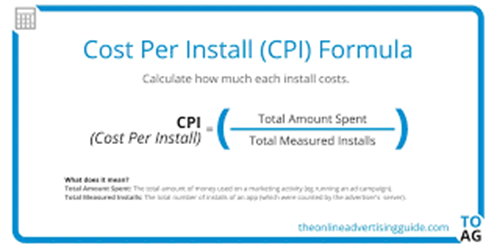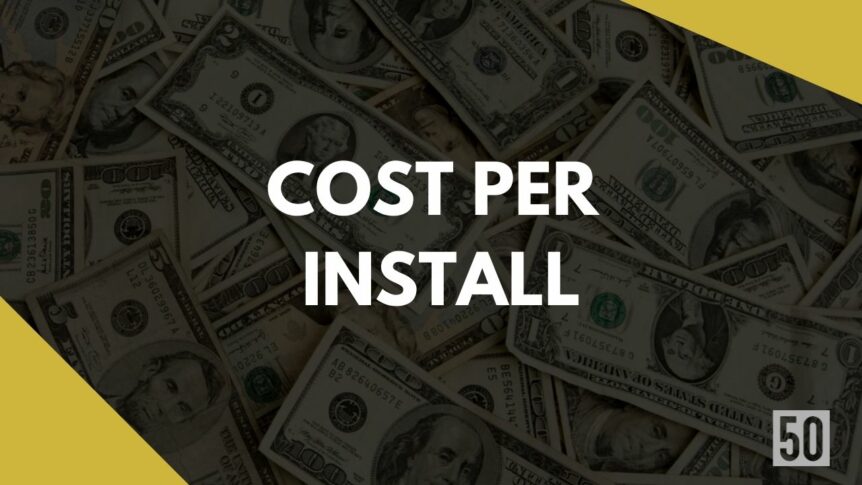Are you looking to start a mobile marketing campaign but don’t know where to start? Or maybe you’re already running a campaign but want to make sure you’re getting the most out of your investment. Either way, cost per install (CPI) is something you’ll want to pay attention to. In this blog post, we’ll break down what CPI is, how it’s calculated, and some best practices for optimizing your campaigns. By the end, you’ll have a better understanding of what goes into generating installs and why they matter for your business. Let’s get started!
What Is Cost Per Install?
Cost Per Install (CPI) is the metric that refers to the price of acquiring a new customer from paid advertisements. This is in contrast to organic installs, which are installs that come organically without any paid advertisement.
So if you’re looking at your CPI and thinking that it’s too high, don’t worry! Just remember that it takes money to make money, and acquiring new customers is an important investment for your business.
After all, without customers, you wouldn’t have a business at all! So take a deep breath, and remember that a healthy CPI is an important part of a healthy business.
Why Is It Important For Startups To Track Their Cost Per Install Metric?
For any startup, it’s important to track your cost per install (CPI) metric. Why? Because your CPI is a key indicator of the health and progress of your business. It tells you how much it costs to acquire each new customer, and it helps you compare your marketing effectiveness across different channels.
If you’re not tracking your CPI, you could be overspending on acquisition or underperforming in key areas. Either way, you’re leaving valuable growth potential on the table. By tracking CPI, you can make informed decisions about where to allocate your resources for the best results. And that’s just good business sense.
How Do You Calculate Cost Per Install?
Let’s say you’re trying to calculate your Cost Per Install (CPI) for a new ad campaign. The first step is to determine your ad spend. This is the total amount of money you’ve spent on the campaign, including any production costs, mileage, etc. Once you have your ad spend figure, divide it by the number of new installs from the ad. This will give you your CPI.
For example, if you spent $500 on the ad and it generated 10 new installs, then your CPI would be $50.
Keep in mind that this is just a rough estimate; there are a number of factors that can affect your CPI, including click-through rate, conversion rate, and more. But this basic formula will give you a good starting point for calculating your campaign’s cost-effectiveness.

What Factors Affect Cost Per Install?
The cost per install (CPI) of a campaign can be affected by several factors. Some of those include:
Audience Targeting:
The more specific the audience, generally the higher the cost per install since advertisers are competing for a smaller market share.
Geography:
Different regions have different CPI costs due to varying levels of demand, competition, and other market factors. For example, North American markets typically have higher CPI costs than other regions such as Asia.
Ad Type:
Different ad formats and placements can affect the cost per install of a campaign. Ads that appear at the top of search results, on popular news sites, or in premium video placements may have higher costs due to competition from other advertisers.
Seasonality:
CPI costs are typically higher around major holidays, events or when there is a high demand for ad placements.
Ad Quality:
Poorly designed ads or those with low-quality images and the copy can lead to a higher cost per install, as fewer people may be engaged with the ad.
Product Quality:
Poorly designed apps or games can lead to high uninstall rates, which will negatively impact your CPI costs.
Campaign Optimization:
If campaigns are not optimized and adjusted in real-time to maximize performance, CPI costs may be higher than they need to be.
By understanding the factors that affect cost per install and taking steps to optimize your campaigns, you can ensure that you are getting the most out of your ad budget.
Advice From The Mobile App Experts
Alex Walz, Head of Growth at Lighter Capital, emphasizes the importance of using Cost Per Install (CPI) in combination with Average Revenue Per User (ARPU) to accurately calculate the return on investment from marketing activities. This insight can help businesses make informed decisions about their strategies and ensure they are making the most out of their efforts.
Artyom Dogtiev, Content Editor at Soku Media, asserts that Cost Per Install is an essential metric for mobile app owners to measure. Companies that are expanding into the mobile market need to take CPI into consideration when determining their investments in mobile channels to reach out to customers.
What Is A Good Cost Per Install?
There is no one-size-fits-all answer to the question of what is a good cost per install. The amount that businesses are willing to pay for each new user who downloads and installs their app will vary depending on a number of factors, including the app’s purpose, its target audience, and the competitiveness of the market.
However, there are some general guidelines that can help you determine whether your app’s cost per install is within a healthy range. First, take a look at the CPI for similar apps in your category. If your app’s CPI is significantly higher than the average, it could be an indication that you’re spending too much on acquisition.
Additionally, consider the lifetime value of your average user. If your app generates a lot of revenue from in-app purchases or advertising, you may be able to afford to pay more per install than an app with a lower monetization rate.
Ultimately, the best way to determine whether your cost per install is healthy is to track your acquisition costs over time and see how they impact your bottom line.
By doing so, you’ll be able to make informed decisions about how much you’re willing to spend on acquiring new users.
Benchmarks For Cost Per Install
Cost per Install (CPI) is one of the most popular metrics used in mobile app marketing to track user acquisition costs. It helps marketers evaluate their return on investment and make decisions about campaign optimizations. However, it can be difficult to measure CPI accurately since there are so many variables that can impact a user’s decision to install an app.
To make sure you are measuring CPI correctly, there are certain benchmarks you should be aware of.
CPI Across Regions
CPIs can vary across different regions based on the different levels of economic development. The estimate of the average regional CPI is:
- North America: $5.28
- Latin America: $0.34
- Asia-Pacific: $0.93
- Europe, the Middle East, and Africa: $1.03
CPI Across Devices
CPIs also vary depending on the type of device a user is using. The average CPI per device is:
- iOS: $3.38
- Android: $2.24
- Windows Phone: $1.43
CPI Across Categories
The cost to acquire new users also depends on the app category. Some popular categories and their CPIs are:
- Gaming: $3.18
- Entertainment: $1.80
- Utilities: $2.14
- Social Networking: $2.82
- Education: $1.63
By having a better understanding of CPI benchmarks, you can make informed decisions about your mobile app marketing campaigns. Doing research on average CPIs across different regions, devices and categories will help you set realistic goals for user acquisition costs and measure the success of different campaigns.
Strategies To Improve The Cost Per Install
Utilize Targeted App Install Campaigns:
Targeting potential users who are likely to install and use your app can be a great way to improve your CPI. This involves narrowing targeting criteria such as location, demographics, device type, language, interests, and more so you can reach users who are more likely to install your app.
Optimize Your Landing Page:
Make sure your website or landing page is optimized for mobile to reduce the chances of users dropping off due to slow loading times or a clunky design. Additionally, consider using segment-specific creatives and copy that speak directly to each user segment you are targeting.
Improve Your App Store Optimization:
Creating an effective app store listing is essential for all apps, as this will determine how many users you can reach and convert. Make sure your listings have engaging visuals with high-quality screenshots, compelling descriptions, and accurate keywords that appeal to the right user segment.
Track Lifetime Value:
To get the most out of your user acquisition campaigns, it is important to track the lifetime value (LTV) of each user. LTV measures how much revenue a single user will generate over their lifetime usage of your app. Having this data can help you understand which channels and ad sets are driving profitable users so that you can focus on those and improve your CPI.
Utilize Retargeting:
Retargeting is another effective way to maximize the value of each user acquired. By retargeting users who have already been exposed to your app, you can increase engagement levels and ultimately conversions by delivering more personalized ads to those users.
Test Different Ad Formats:
Varying ad formats can help you reach different types of users and test what works best for your app. For example, interactive ads may be more successful than static ones, depending on how your target market responds to the two different types. Experimenting with different ad formats can help you identify which are the most effective and help improve your CPI.
Use Automation:
Utilizing automated tools can help you make the most out of your user acquisition campaigns. Automated tools can optimize bids, budgets, and targeting to ensure that you are bidding on the best-performing channels and reaching users who are more likely to install your app. This can save time and ultimately help you improve your CPI.
By implementing these strategies, you can drive more installs and convert more users while keeping cost-per-install low. However, it is important to continually test different channels and ad formats to ensure that you are making the most out of each user acquisition campaign. With the right tools and strategies in place, you can maximize the value of each user and ultimately improve your CPI.
Conclusion
In short, cost per install is a way of advertising that can be very beneficial to your app if done correctly. By understanding how it works and what you need to do, you can ensure that your campaigns are successful and that you’re getting the most out of your ad budget. So don’t hesitate to give CPI a try – it just might be the boost your app needs to get to the top of the charts.

